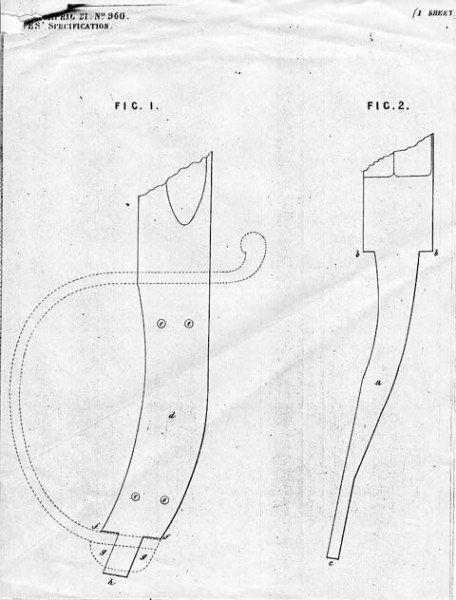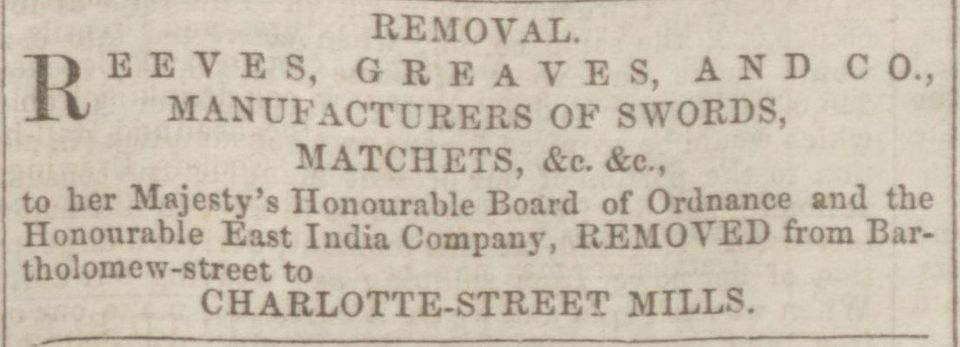An Important Reeves Patent Solid Hilt British Light Cavalry Officer's SwordBy Matt Easton
An Important Reeves Patent Solid Hilt British Light Cavalry Officer's Sword
By Matt Easton
This sword, currently in the author's collection, is historically important in the history of British military swords because it is one of the earliest swords documented to feature Charles Reeves' 'Patent Solid Hilt', or full-width tang construction.
The Patent Solid Hilt was a non-regulation feature which was intended to produce a stronger fighting weapon. At first, the feature was applied by Reeves to officers' swords and also under licence by Government-contracted suppliers to the new 1853 pattern cavalry troopers' sword (the full width tang then being applied to all subsequent British Army cavalry troopers' swords until the introduction of the 1908 pattern).
However as early as 1854 the Wilkinson records show that they were producing the Patent Solid Hilt also on officers' swords, presumably while paying a royalty fee to Reeves. The feature was an expensive extra, which officers could pay for if they thought it was worth it, either for added strength in combat, or perhaps to some extent as a sign of prestige.
It is notable that many Patent Solid Hilt swords date to major campaigns, such as the Crimean War, the Indian Mutiny, the Sudan expeditions and the Second Anglo-Boer War. They are often also associated with Indian service, where swords were in general more likely to see combat use. The feature was offered as an optional extra on officers' swords from 1853 until WW1 in general.
Patent Solid Hilt officers' swords were usually the products of either Reeves or Wilkinson's workshops in the early years and these two companies seem to have had a close operating relationship. Reeves was the biggest manufacturer of swords in Birmingham (until Robert Mole & Sons later took that place) and Wilkinson was the largest in London. Reeves went bankrupt in 1869 and then returned to sword making on a smaller scale, but in 1883 Wilkinson bought a large share in the company and later completely absorbed it.
Most surviving Patent Solid Hilt swords are therefore Wilkinsons, however a few other makers did copy the feature, whether under official licence or not it is not currently known. The author has seen examples of the solid hilt made by Pillin and Mole for example. As well as examples with only retailers' names on, such as Phillips (which could have been made by Reeves for the retailers), which could have been made by Reeves, Wilkinson, Mole, Pillin or someone else. There were not actually many sword makers in Britain by the 1850s and a few companies were making most of the sword blades, which were then etched with the retailer's details.
The concept of the patent itself is a little questionable, because full width tangs were of course not a new invention. They had been used on swords and knives for centuries and even in Reeves' time many Bowie knives were being produced with full width tangs. The 1831 pattern General's mameluke sword is essentially a full width tang, and that was produced throughout the period by a range of makers.
The Reeves patent, specifying the details of the full width tang design, was applied for by Charles Reeves on 21 April 1853 and approved on 20 October 1853. But this is where the importance of this specific sword presents itself. By 1853 Charles Reeves was operating from Charlotte Street in Birmingham. Yet this sword has the address of Bartholomew Street in Birmingham. This was the address that Reeves and Co were operating from in 1851, when they received a prize for their swords at the Great Exhibition.
So this sword pre-dates the patent which created the official 'Patent Solid Hilt'. This ties in with the fact that there is no mention of a patent on the sword itself, unlike swords from 1853 onwards, yet there is the word 'Registered' on the spine of the blade.
Supporting this is the early construction method of the hilt itself, which seems like a prototype of the more standard construction that would follow from 1853 onward. In this example the grips are made of pressed leather and the rivets holding them on are exposed. Most notably, there is no backstrap - the tang is visible at both front and back. On post-patent examples there is usually a backstrap enclosing the back edge of the tang. In this example they have actually chequered the back edge of the tang and the pommel, whereas on later examples it is usually the backstrap that is chequered.
Since originally drafting this article and thanks to the detective work of Jordan Pryce Lewis, I can now confirm that this sword must in fact pre-date 1 September 1851, because that is when Reeves moved from Bartholomew Street to Charlotte Street.
Birmingham Gazette, 1 September 1851:
I am aware of only one other Patent Solid Hilt type construction with this address under Reeves' name, that being a very similar sword in a private collection, but with a heavy cavalry officer's hilt.
My conclusion therefore is that these two swords are rare survivals of the pre-patent prototypes being made by Charles Reeves.
My specific example here is in such perfect condition that I doubt it has seen service, despite the fact that it is sharp. Not only is the blade in almost brand new condition, but even the surface of the leather grips and the grip wire in in top condition. My presumption is that it was made sharp from the outset, rather than service sharpened, because it was an example for exhibition or to show proof of concept. It may even be that this sword and the heavy cavalry example like it were once displayed together by Reeves, to show the different branches of the service. We will probably never know exactly, but this remains an important sword to document.




